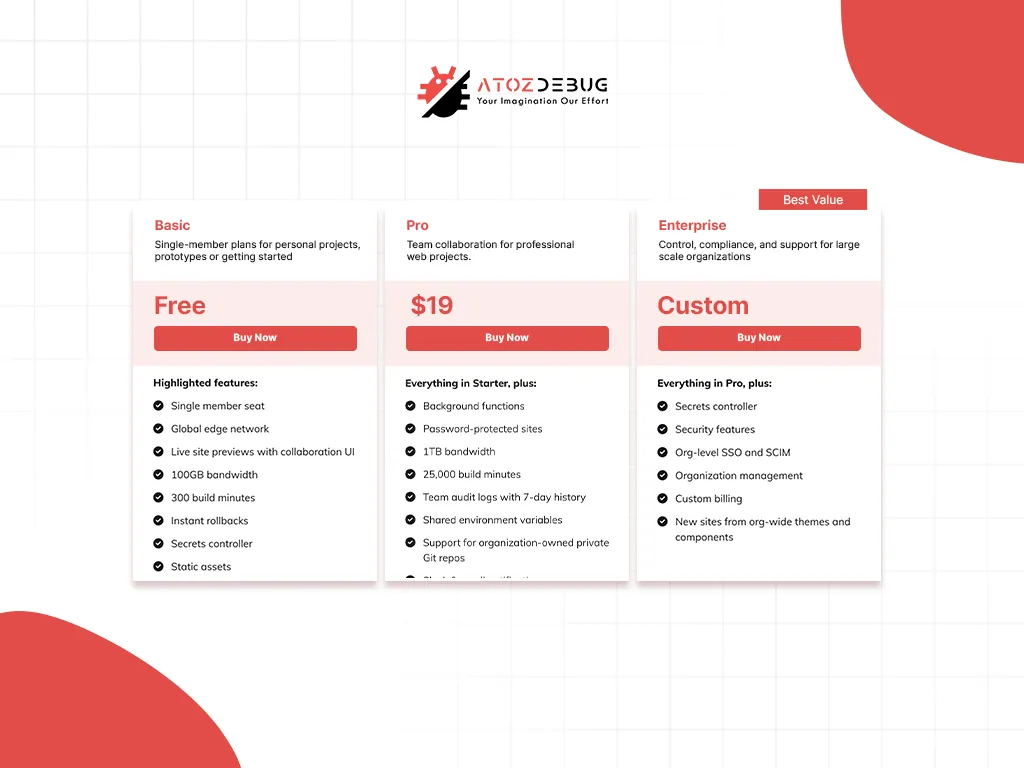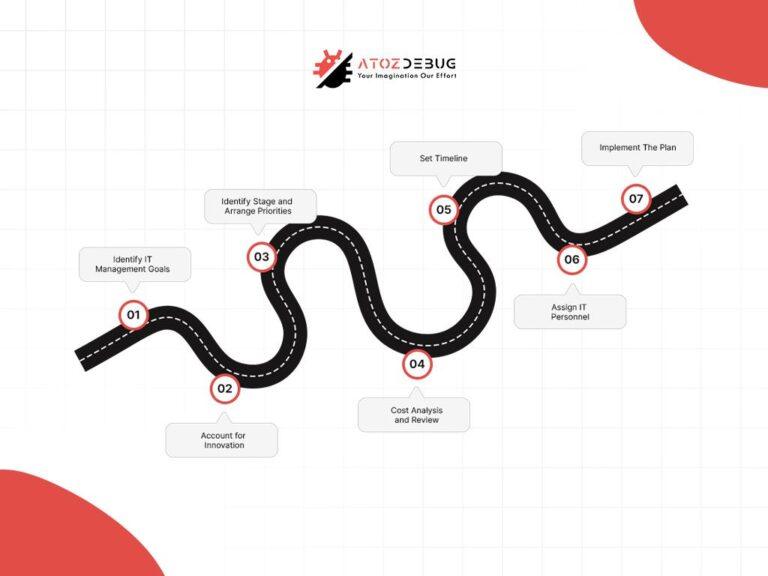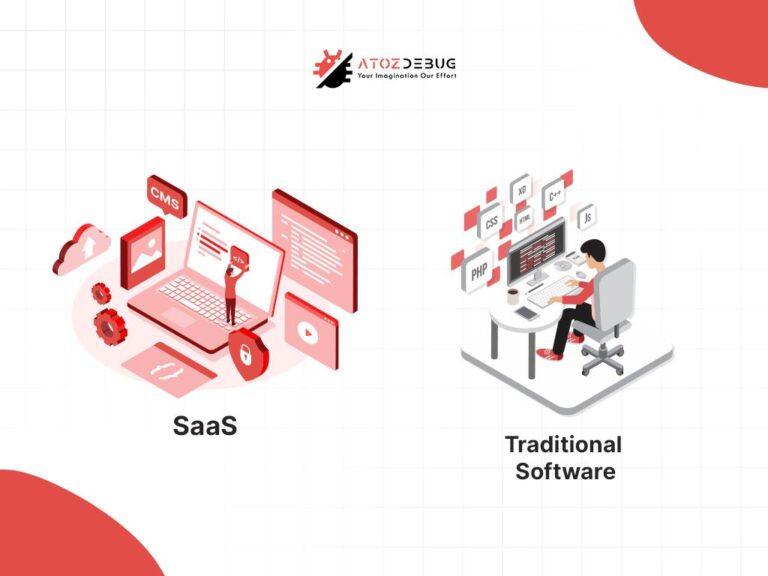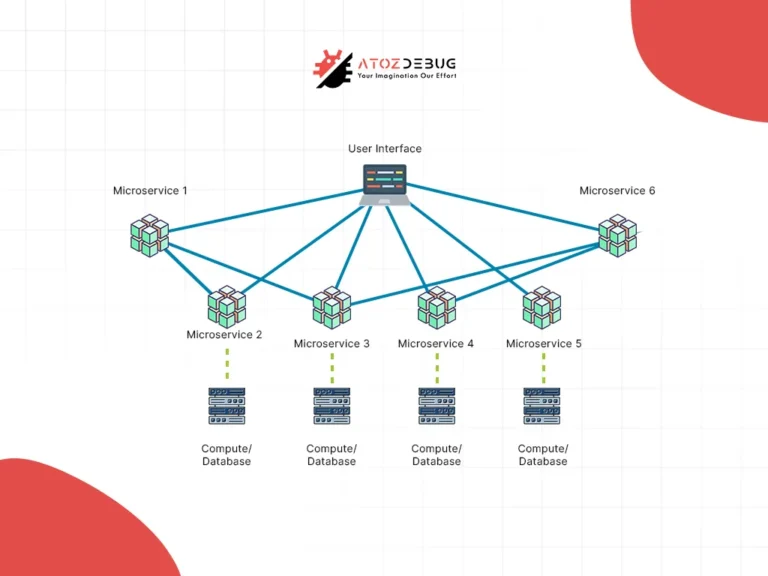Pricing can make or break any SaaS company. Set it too high, and potential customers may walk away. And, if it’s too low, they may see your product as less valuable. That’s why, a well-planned pricing strategy is important. It can drive revenue, keep customers longer, and reduce churn. But how exactly do you find the right balance?
Successful SaaS pricing means more than just picking a number. It’s about knowing what customers want, market demand, and how pricing models influence buying behavior.
Strategies like price anchoring, charm pricing, and product bundle pricing can significantly impact conversion rates and deal cycles. At the same time, techniques like dynamic pricing and decoy pricing help optimize revenue based on customer segments and pricing psychology.
Keep reading as this article will explore the most effective pricing strategies for SaaS companies. Here, you’ll learn how they work, why they’re important, and how they can help you can use them to maximize revenue and customer retention.
How Price Anchoring Boosts SaaS Revenue?
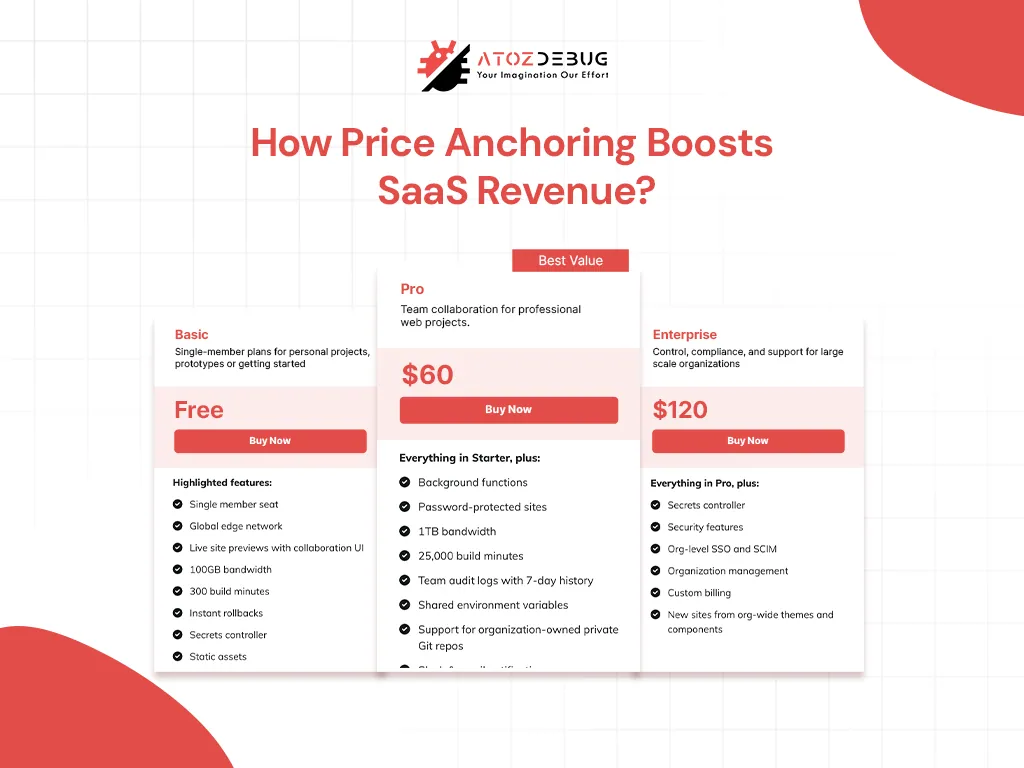
Price anchoring is a psychological pricing strategy where a high initial price (the anchor) is set as a reference point. This tactic influences how customers perceive value, which makes lower-priced options seem more attractive.
SaaS companies use this approach to guide purchasing decisions and increase revenue.
How Price Anchoring Works in SaaS?
SaaS companies implement price anchoring through various methods, such as:
1. Tiered Pricing: Companies offer multiple pricing plans. The most expensive one acts as an anchor, which makes the mid-range plan seem more affordable and valuable. For example, if a SaaS company has three plans: $30, $60, and $120; the $120 plan makes the $60 option look like a good deal.
2. Decoy Pricing: A company might add a plan not to sell it but to make another option look better. For example, if there are two plans: one at $50 and another at $100; the company might add a third option at $90 with fewer features. This makes the $100 plan seem like the best value, which encourages customers to go for it.
3. Discount Framing: Showing an original high price next to a discounted price makes people feel like they are saving money. If a software plan is priced at $99 but shown as “Originally $149”, customers believe they are getting a great deal, increasing the chances of purchase.
Through these tactics, businesses increase conversions and maximize revenue per customer.
Psychological Impact of Anchoring
When consumers see a high price first, their subconscious price reference is set. This makes other prices seem more affordable in comparison. Additionally:
- Perceived savings: Customers feel they are getting a great deal when they see a discount.
- Fear of missing out (FOMO): Limited-time discounts or premium plan comparisons create urgency.
- Value perception: A higher-priced option makes mid-tier plans appear more valuable.
These psychological triggers lead to higher purchase rates and greater revenue for SaaS businesses.
Real-World Example
HubSpot, a leading SaaS company, uses price anchoring effectively. Their Enterprise plan is positioned as the most expensive, which makes the Professional plan seem like the best value. This strategy boosts more customers to choose the mid-tier option and increases overall sales.
The Charm of Odd-Even Pricing in SaaS
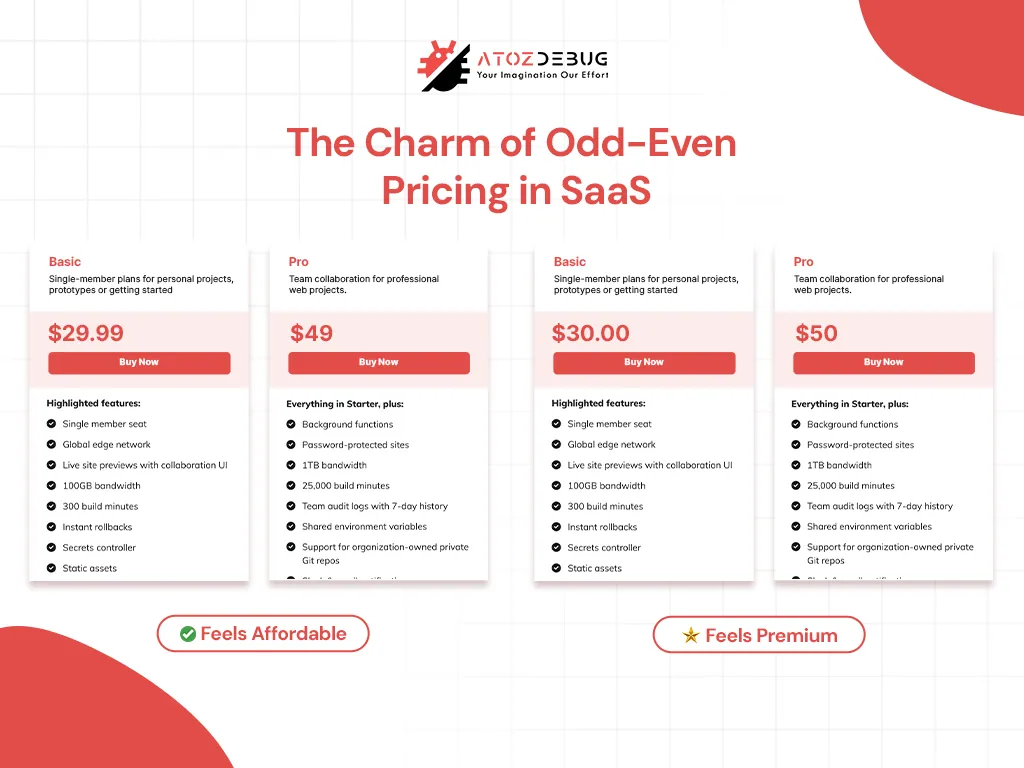
Pricing strategies can influence how customers feel about a product. One of the most effective techniques in SaaS is odd-even pricing, a variation of charm pricing.
This method involves setting prices that end in odd numbers (like 9 or 7) or even numbers (like 0 or 5) to shape customer perception and increase conversions.
Why Odd-Even Pricing Works?
People often see odd prices, like $9.99 or $19.97, as more affordable. The small difference makes it feel like a better deal, even if the actual price drop is just a few cents. Many SaaS companies use this trick to make their pricing plans look budget-friendly.
On the other hand, even-numbered prices, like $20, $50, or any, are perceived as premium and reliable. Those businesses that are offering professional or enterprise-level plans often use even pricing to reinforce the idea of quality and stability.
How SaaS Companies Can Use Odd-Even Pricing
To find out what works best, businesses can run A/B tests. For example, a SaaS company can offer a plan at $29 and another at $30 to see which one attracts more customers. If more people choose the odd price, it’s clear that charm pricing is the better option.
Another way to test pricing is through customer feedback. Some users prefer even pricing for high-end services, while others respond better to charm pricing for lower-cost plans.
By using odd-even pricing, SaaS companies can increase sales, attract the right customers, and grow their business while keeping their pricing strategy simple and effective.
Product Bundle Pricing for Subscription Success

Finding the right product bundle pricing strategy is essential for SaaS companies looking to increase revenue and customer retention.
When done correctly, bundling multiple services into a subscription service package can provide value to customers while ensuring steady, recurring income for the business.
Why Bundling Works for Subscriptions
Subscription businesses make money from long-term customers. Bundling related products together has many benefits:
#More Value for Customers: A bundle offers more for less, which makes it a great deal.
#Better Customer Retention: People using multiple features are less likely to cancel.
#Higher Revenue: Customers often pick a bundle over a single product, leading to more sales.
How to Price Product Bundles the Right Way
To make bundling successful, follow these steps:
- Know What Customers Want – See which products are often used together. Bundling them makes the buying process easier.
- Create Different Pricing Packages – Offer bundles at different price points. A basic bundle for small users and a premium one for bigger needs can work well.
- Allow Flexibility – Some customers may want to buy products separately. Giving them options makes bundles more attractive.
- Set a Smart Price – The bundle should be cheaper than buying items separately but still profitable.
- Explain the Benefits Clearly – Tell customers how the bundle saves money and improves their experience.
A well-planned product bundle pricing strategy can help SaaS companies attract more subscribers and keep them for the long term.
Decoy Pricing and Its Impact on Customer Choices
Decoy pricing is a smart pricing psychology technique that helps businesses guide customer decisions. By introducing a less attractive option next to a preferred one, companies can make the preferred choice look like the best deal. This strategy works because customers often compare options rather than evaluating prices independently.
For SaaS businesses, decoy pricing can significantly influence different customer segments by shaping their perception of value. When a pricing plan is carefully designed with a decoy, customers are more likely to choose the option that maximizes revenue while still feeling they are making a smart purchase.
For example, if a SaaS company offers three pricing plans
- Basic Plan – $10/month
- Pro Plan – $30/month
- Enterprise Plan – $50/month
To encourage Pro Plan purchases, a decoy plan can be introduced:
- Pro Plan (Limited Features) – $29/month
- Pro Plan (Full Features) – $30/month
Since the full Pro Plan offers significantly more value for just $1 extra, customers are more likely to select it. Decoy pricing works because people don’t always analyze every detail when making decisions. Instead, they compare options and choose what seems like the best deal. The decoy plan acts as a reference point, making the preferred option look like the smartest choice.
To implement this strategy effectively, SaaS businesses should:
- Identify their most profitable pricing plan.
- Introduce a decoy that highlights the value of the preferred plan.
- Test different pricing structures to see which influences customer behavior the most.
In short, by using decoy pricing, SaaS companies can increase conversions and boost revenue while ensuring customers feel they are getting the best deal.
Dynamic Pricing Flexibility for SaaS Growth
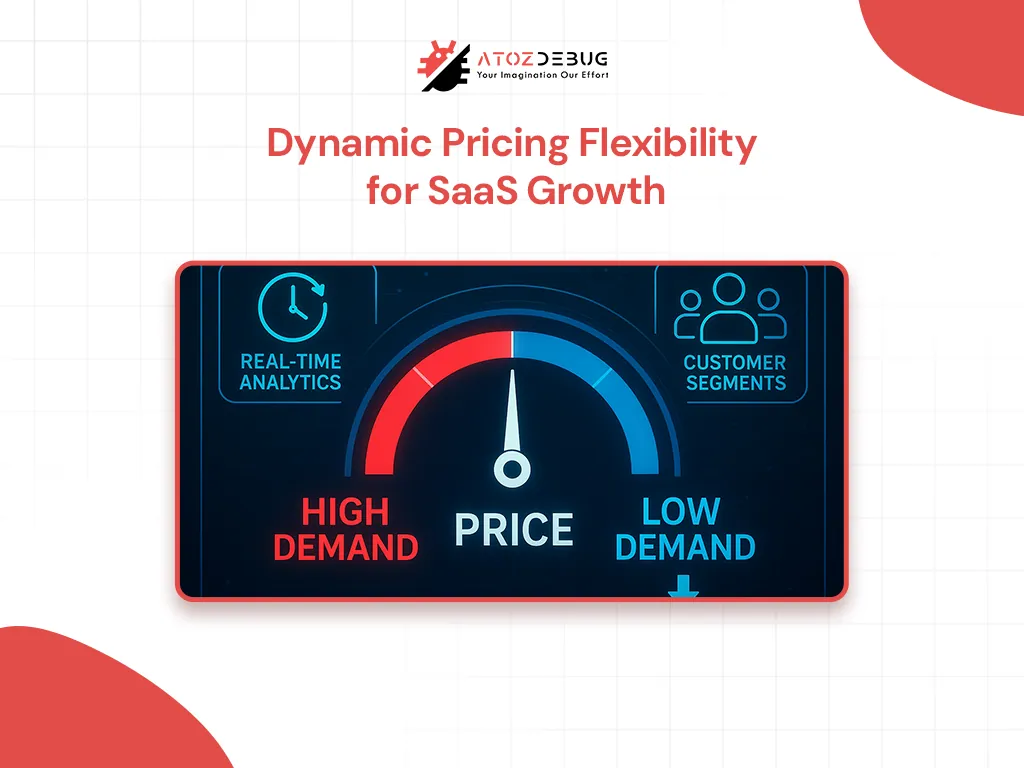
Flexible pricing is important for SaaS businesses to grow successfully. Unlike fixed pricing, dynamic pricing lets companies adjust their rates based on demand, customer behavior, and competition. This helps keep prices fair, competitive, and relevant in a changing market.
Let’s see how this strategy helps SaaS companies grow effectively:
Make Smart, Data-Driven Decisions
One of the biggest advantages of dynamic pricing flexibility is that it helps companies make data-driven decisions. By analyzing customer behavior, competitor pricing, and market demand, SaaS businesses can set the right price at the right time.
For example:
- When more people want the product, the price can be raised to earn more money.
- During slow periods, discounts can attract more customers and keep sales steady.
This smart approach ensures that pricing always matches real-time business needs.
Stay Ahead of Competitive Pressures
The SaaS market is highly competitive, with new players entering every day. Dynamic pricing flexibility helps companies respond quickly to competitive pressures. If competitors lower their prices, businesses can adjust their own pricing to stay attractive.
Moreover, personalized pricing for different customer segments, like startups, enterprises, or individual users, ensures that all types of customers find value in the product.
Balance Flexibility with Customer Trust
While dynamic pricing offers great benefits, it must be done carefully. Changing prices too often can confuse or upset customers. The best approach is to:
- Use real-time analytics to guide pricing decisions.
- Test pricing strategies before making big changes.
- Clearly communicate pricing updates to customers.
By following these steps, SaaS businesses can enjoy growth and stability while keeping customers satisfied. In the long run, flexible pricing helps increase revenue, attract more users, and stay competitive in a changing market.
SaaS Pricing Strategies at a Glance
If you just want a quick snapshot of each strategy, this table breaks it down so you can instantly see which one might fit your business best.
| Pricing Strategy | Best For | Pros | Cons | Example |
|---|---|---|---|---|
| Price Anchoring | Businesses with tiered pricing plans | Makes mid-tier options more attractive, increases perceived value | Can backfire if anchor price feels unrealistic | HubSpot using Enterprise tier to make Professional tier look affordable |
| Charm Pricing | SaaS products targeting cost-sensitive users | Makes products feel cheaper, boosts conversions | Less effective for premium services | $9.99 plan instead of $10 for budget-conscious customers |
| Bundle Pricing | Companies with multiple features or tools | Increases retention, higher revenue per user | Needs careful pricing to stay profitable | Adobe Creative Cloud bundling multiple apps |
| Decoy Pricing | Businesses wanting to guide users toward a specific plan | Steers customers to profitable plans, improves decision-making | Can confuse users if poorly executed | Adding a $90 plan to make $100 plan seem like a deal |
| Dynamic Pricing | SaaS companies in competitive or seasonal markets | Maximizes revenue based on demand, flexible | Price changes can upset customers if frequent | Ride-hailing apps adjusting rates during peak hours |
How to Choose the Right SaaS Pricing Model (Step-by-Step)
Picking the right pricing strategy isn’t just about copying what competitors are doing—it’s about understanding your product, customers, and growth goals. Here’s a simple roadmap you can follow:
1. Know Your Audience
Identify who your customers are, what they value most, and how much they’re willing to pay. For example, startups might prefer affordable entry plans, while enterprises value feature-rich packages.
2. Study Your Competitors
Look at how similar SaaS companies price their products. You don’t have to match them exactly, but knowing the market range helps you position yourself competitively.
3. Match Strategy to Goals
If your goal is fast adoption, consider charm pricing or aggressive bundles. If you want high revenue per customer, price anchoring or decoy pricing might work better.
4. Test, Don’t Guess
Run A/B tests for different pricing tiers or formats. This gives you data-backed insights instead of relying on assumptions.
5. Monitor and Adapt
Your pricing model should evolve as your business grows. Review conversion rates, churn, and customer feedback regularly to see if adjustments are needed.
By following these steps, you’ll have a pricing structure that feels fair to customers, supports your revenue goals, and adapts to market changes.
Conclusion
Overall, a smart SaaS pricing strategy helps boost revenue and keep customers for the long term. When you use techniques like price anchoring, charm pricing, bundle pricing, decoy pricing, and dynamic pricing, it can make your pricing more effective and increase sales.
Key Takeaways:
- Price Anchoring makes mid-tier plans look more attractive by shaping customer perception.
- Charm Pricing (like $9.99 instead of $10) makes products feel more affordable and boosts sales.
- Bundle Pricing encourages customers to spend more by offering value-packed deals.
- Decoy Pricing guides customers toward the best-value option.
- Dynamic Pricing adjusts based on demand and market trends to maximize profits.
Your pricing strategy should evolve with your business. Keep refining it to match market trends and customer expectations. Want to optimize your pricing for better growth and retention? Start experimenting today, and don’t hesitate to explore new approaches. A well-planned pricing model can be the difference between average growth and long-term SaaS success.
Need help in creating a pricing plan that works? Explore more SaaS pricing strategies or contact us for a personalized pricing plan that fits your business.
FAQs
1. What is the most common SaaS pricing strategy?
Tiered pricing is one of the most common approaches. It gives customers options at different price points, making it easier for them to choose a plan that fits their needs and budget.
2. How do I know if my SaaS pricing is too high or too low?
Check your conversion rate and churn rate. If conversions are low, your price may be too high. If churn is high, you might not be delivering enough value for the price, or you may be targeting the wrong audience.
3. Should I offer monthly or yearly billing?
Offering both is ideal. Monthly billing is great for attracting new customers, while yearly billing encourages long-term commitment and improves cash flow.
4. How often should I update my SaaS pricing?
There’s no fixed rule, but most successful SaaS companies review their pricing every 6–12 months to adjust for market trends, new features, and customer feedback.
5. Can I change my SaaS pricing without losing customers?
Yes, but communicate changes clearly and offer existing customers a grace period or “grandfathered” pricing. Transparency helps maintain trust during pricing updates.
6. What’s the best way to test SaaS pricing?
A/B testing works well. Present different price points or package structures to separate customer groups and compare which performs better in terms of conversions and retention.

